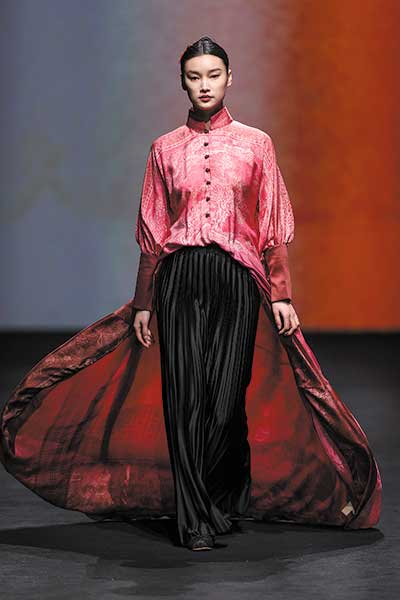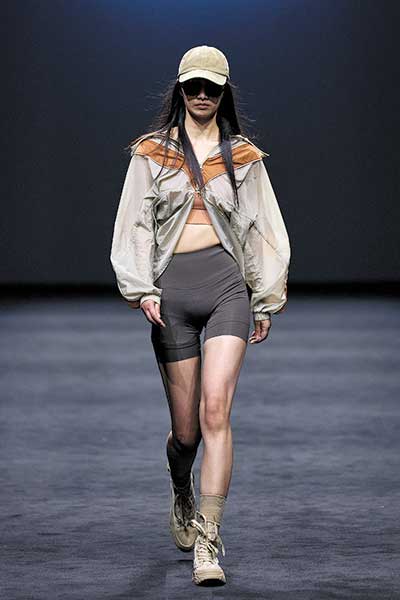New frontiers come into fashion

Hemu, a brand known for its contemporary twist of traditional Chinese patterns, presents its latest collection at Shanghai Fashion week.[Photo provided to China Daily]
The Autumn/Winter 2024 Shanghai Fashion Week, held in late March, centered around the theme "new Chinese style, new sustainability, and new sports", reflecting the evolving fashion landscape within the city, a burgeoning fashion capital.
The event highlighted the emergence and popularity of the new Chinese style, showcasing the innovative designs of young, talented designers and attracting participation from various organizations. Approximately 25 percent of independent brands incorporated Chinese aesthetics into their autumn/winter collections on display at the Mode fashion exhibition.
Raxxy, a Shanghai fashion brand, drew attention with designs inspired by Chinese traditional bamboo weaving. Co-founder Shen Weilian integrated Chinese cultural elements with 3D technology, presenting a collection featuring phoenix and dragon patterns, which garnered significant interest in the European market.
In an effort to promote innovation on fashion within China, Raxxy previously showcased vibrant Chinese aesthetics at Milan Fashion Week and expressed a desire for domestic buyers to appreciate such creativity at the Shanghai Fashion Week.
The Shanghai event also introduced a new Chinese fashion exhibition at the Shanghai Opera House, featuring representative brands, such as Vivienne Tam, Heaven Gaia, and Maying, showcasing their latest collections.
The growing popularity of China-chic and new Chinese style-related products among consumers has seen a substantial increase in sales and turnover.

Chinese aesthetics dominate the creations by Linghe.[Photo provided to China Daily]
Liu Peifang, deputy secretary-general of the Shanghai Garment Trade Association, highlights a significant increase in the number of Chinese consumers purchasing China-chic and new Chinese style-related products, with a 174 percent rise from 2019 to 2022. Additionally, the turnover surged by 355 percent during the same period.
Speaking at a forum held at the Shanghai Opera House during the fashion week, Liu emphasized the growing understanding of Chinachic and new Chinese style led to a comprehensive attention to product quality, spiritual core, value creation, and cultural expression.
Liu Yanqiong, brand director of leading Chinese silk products brand Wensli, notes the brand's continued sales revenue growth, particularly for their star products, such as silk scarves.
She has observed a shift in consumer preferences, with a decline in the popularity of products resembling those of luxury brands like Hermes, and a rising demand for products featuring Eastern elements and Chinese traditional patterns, which now account for two-thirds of their sales.
According to a report by CCTV Finance, Caoxian county in Shandong province, a major production base of hanfu (traditional attire of the Han ethnic group) in China, achieved a sales revenue of 7 billion yuan ($966 million) in hanfu last year. The mamianqun, which literally means "horseface skirt" and is one of the favorites among younger generations, garnered sales of 550 million yuan from January to February this year.
Amid the rise of the new Chinese style, Lin Jian, the co-founder of Showroom Shanghai, expresses concerns about the sustainability of the trend.
He questions whether the remarkable revenue achieved by Caoxian truly reflects the enduring success of new Chinese style clothing brands. He points out that the traditional wholesale model, focused on pursuing sales volume at low prices, continues to underpin the popular phenomenon.
A decade ago, Showroom Shanghai was launched with the belief that independent designers and the traditional market-oriented wholesale model were not sufficient. Lin hopes that through their platform, designer brands could gradually transition toward branding, aiming for sustainable growth within the industry.

Models strut on the runway displaying creations by Merrycheng, a Chinese brand committed to high-tech fabrics, during the fashion week.[Photo provided to China Daily]
From vision to action
The fashion industry in China has long been dedicated to achieving sustainable development. This season's M Space forum, which invited industry leaders to discuss and contemplate, has reflected the fact that sustainable development is no longer merely a slogan but is gradually permeating various sectors of the fashion industry.
In the discussion on how sustainable fashion can transition from "vision" to "action", the efforts and reforms made by traditional apparel companies have been underscored, alongside the exploration of sustainable development by emerging brands.
Esquel Group, a textile and apparel giant committed to sustainable development for decades, reveals that the company has reduced water consumption per unit by approximately 70 percent since it began collecting data in 2005, which is equivalent to saving the amount of water in 4,800 standard swimming pools annually.
Cai Wei, CEO of the high-end shirt brand Determinant owned by Esquel Group, addresses the transformation of an abandoned quarry in Guilin, Guangxi Zhuang autonomous region, into a sustainable park that includes spinning and weaving factories.
"Guilin is recognized as one of the most beautiful environments in the world, and our work there showcases that although the textile industry is a traditional industry, it can be conducted in a nontraditional and sustainable manner," Cai says.
He further introduces the group's launch of a series of recyclable and renewable products, such as a waterless dyeing product that achieves zero water usage and emission during the dyeing process, saving 40 liters of water per garment. Additionally, the group supports the sustainable development of its employees by sending them to college and conveys sustainability concepts to children through various activities.

Models strut on the runway displaying creations by Merrycheng, a Chinese brand committed to high-tech fabrics, during the fashion week.[Photo provided to China Daily]
"Sustainable development should not be merely a slogan. We are committed to promoting the sustainable development process of the entire textile and clothing value chain in China, and also hope to collaborate with our consumers to create a green and sustainable future," Cai emphasizes.
In addition to focusing on sustainable products, fashion brands can also convey values through other means. Apparel-making giant Youngor launched a commercial entity, HAI 550, in downtown Shanghai in December, with the aim of promoting sustainable lifestyle development by connecting brands and consumers in this sustainability-oriented space.
According to Yang Jing, the marketing director of HAI 550, the space will collaborate with brands and operators dedicated to sustainable lifestyles.
A 400-square-meter exhibition area on the first floor is linked to sustainable and high-quality lifestyles, where community activities will also take place. "We aim to attract people to naturally walk in as they pass by," Yang says.
Chen Yidi, a former fashion editor, founded the bio-based materials' innovation institution MATTER to explore sustainable materials.
"Sustainability, regardless of its dimensions, is a systematic practice that requires every element and point in the fashion industry to be connected into a line. And now we are not just talking about lines; we need to become a closed-loop model to achieve a truly sustainable vision," says Chen, expressing her desire to contribute to the industry's development.

New Chinese style is one of the themes at Shanghai Fashion Week.[Photo provided to China Daily]
Outdoor outfits
In addition to the pursuit of a new Chinese style and sustainability, the domestic fashion industry has witnessed a growing trend in urban outdoor outfits, spurred by the burgeoning interest in outdoor activities in recent years.
Moution, an outdoor fashion brand specializing in sun protection, made its debut at the Shanghai Fashion Week, following its unveiling at London Fashion Week a month earlier in collaboration with the designer brand Roksanda.
"The pandemic has heightened people's interest in outdoor life and connecting with nature. Moution is a brand that has emerged in response to this trend," explains Lu Ping, co-founder of Moution.
Lu highlights that lightweight outdoor attire, originating from the European and American markets, is gaining traction in China, emerging as one of the most promising tracks in fashion.
The number of outdoor enthusiasts is projected to reach 730 million, Lu says. "These individuals have sparked significant creativity for the development of the sports and outdoor retail market. Among all outdoor functional clothing, the sunscreen clothing category is experiencing rapid growth."
According to Xinhuanet, the annual growth rate of China's outdoor sportswear over the past three years has surged by 20 percent. The sales volume of outdoor jackets reached 1.13 billion yuan in the first half of 2023 on the short-video sharing platform Douyin, nearly five times higher than that in the first half of 2022.

Raxxy's designs inspired by Chinese traditional bamboo weaving.[Photo provided to China Daily]
The designer of the Japanese outdoor fashion brand, Norbit by Hiroshi Nozawa, presented new collections in China for the first time at the Shanghai Fashion Week since the brand's establishment in 1999, underscoring the expanding market based on insights from foreign designers.
"Chinese design language, including inspiration, has significantly improved compared to 20 years ago and demonstrated a strong understanding and acceptance of this outdoor fashion trend culture. I hope my brand will garner more attention here," Hiroshi Nozawa said during the urban outdoor round table Go Field.
Liu Hongwei, a video blogger and co-founder of the urban outdoor brand Watch the Wind, elucidates the burgeoning trend based on his observations. "The surge in popularity of outdoor activities in China has been sudden."
Camping-related products nearly sold out online during the May Day holiday in 2020. "At that time, partly influenced by the pandemic, everyone saw spending time with family and friends in outdoor settings as a positive pursuit. Gradually, the trend evolved toward hiking, skiing, and mountaineering, leading to significant growth in recent years," says Liu Hongwei.
In addition to an overall upswing in the urban outdoor and sports industry, some specific trends have emerged, such as a heightened professional understanding of fabrics and increased female involvement in the outdoor market.
"We've noticed a growing number of female consumers in our urban outdoor clothing segment, and we should introduce more designs tailored to women," says Zhu Yide, founder of Element, a specialty store focusing on outdoor collections.
"Consumers have shifted from solely relying on cotton clothing to seeking more information about technical fabrics and material data. I believe this is an evolving process, and overall, it is a positive development."

Handbags by Xiangshang on display at Shanghai Fashion Week.[Photo provided to China Daily]
